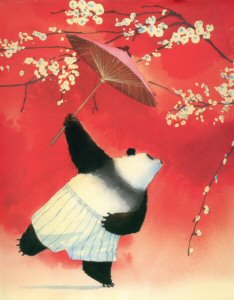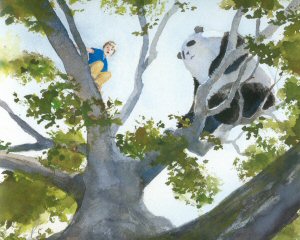Children’s books that are fun for both the parent and the child to read are a definite boon. While there is a cornucopia of great stuff out there for older kids that I would love to read to someone–hell, I often read them for myself–it’s a little slimmer pickings for picture books. And the problem of finding that type of book with something to offer both reader and “read to” is even more important because you often have to read the same book several times a day for several days in a row.
A significant portion of Sarah’s burgeoning library are books that I’ve selected because there’s something in there for me as well as for her. The best example of this lately are Jon J. Muth‘s three children’s books.
Looking at Muth’s lovely art several times a day over several days is a treat, not something to endure, and the stories have the benefit of being simple and conveying important lessons in a non-didactic manner. Also, the balance of image to text is just right for someone Sarah’s age, who understands enough to follow the story, but not to compelled by a story that comes without enough pictures.
The three books are:
 Zen Shorts
Zen Shorts- This is probably Sarah’s favourite of the three, and it’s also mine. I’m not going to kid myself that Sarah enjoys it for the same reasons I do–she’s probably just into it because it has a panda–but that’s OK. It’s a story about two brothers, their sister, and their new neighbour, a panda. After they meet, the children each visit the panda, and in the course of their time together he tells them a zen tale that highlights some principle in a person’s approach to the world. The illustrations come in two different styles: Muth’s trademark watercolours for the framing story, and a zen-appropriate ink brush B&W style for the three tales-within-the-tale. While I love Muth’s art, I actually enjoy this story most because I think the little zen lessons might be sinking in for Sarah. I’m sure she isn’t consciously getting their points, but let’s start early with lessons about forgiveness and understanding the cost of anger, what kind of things are really important, and how to react to both good and bad luck.
The image starting this post is the back cover of this book, and the image at the end is a detail from inside. Not shown is the inkbrush image of the naked bear enjoying the moonlight that stops me every time.
 Stone Soup
Stone Soup- This one is the least successful of the three as a story, but the art is still tremendous. And the problems with the story don’t seem to bother Sarah, who has been asking a lot lately to read the “Hok, Lok, and Siew” story.
In this book Muth has taken the old trickster story and moved it to China. While this leads to some lovely art, the decision to switch the protagonists from hungry tricksters to Buddhist monks is actually the story’s downfall. See, the monks don’t want to get fed, and the stone soup isn’t a trick to get them fed, it’s a way to illustrate to the villagers the happiness that comes from sharing. While I’m all for sharing, and really don’t mind if Sarah picks up on that, I am also a big fan of the trickster tales and losing that aspect of the story hurts it. There’s no funny in this version, since the trick is pedagogical, and the whole thing seems a bit “preachy”, something Muth avoids in the other two books. The idea that the villagers can be tricked into sharing, and then their whole lives change just doesn’t work.
Still the watercolor illustrations here, with their cool and foggy backgrounds, and bright vivid foregrounds, are lovely. Hell, just the endpapers of this book are worth the price.
 The Three Questions
The Three Questions- Yes, I’m reading Tolstoy to my two year old. Kind of. Here, the Tolstoy story is translated into a children’s book, with the roles of the czar and his companions being played by a boy and his talking animal pals. The titular questions, “When is the best time to do things? Who is the most important one? What is the right thing to do?”, are addressed as in the story, with the answers from the animal friends not satisfying our protagonist. He later finds the answers he can live with, after learning some lessons about altruism and brotherhood.
Here, as in the Zen Shorts book, Muth manages to deal with moral lessons in a concise way without being preachy. Admittedly, he got a head-start from Tolstoy, but putting this into a form that’s accessible to kids (albiet perhaps kids a bit older than Sarah) is no small feat.
And again, the art is outstanding. This time the backgrounds play an important role, and change as the relationships of the characters change with them. And that’s only one of the bits of subtle symbolism that’s going on in the pictures. Adults can find things in the art to interest them, even on multiple rereadings, while the surface images appeal to the real “target demo”.
Oh, and in case you aren’t convinced to get the book (and haven’t read Tolstoy), Muth’s formulation of the answers?: “There is only one important time, and that time is now. The most important one is always the one you are with. And the most important thing is to do good for the one who is standing at your side.” I’m quite looking forward to the time when Sarah and I can discuss the answers, and their fitness.
For some reason Sarah isn’t a big fan of this one, despite the panda cameo. I suspect she’ll come around eventually.
While I’m waiting for Sarah to be old enough to be able to get pulled into the narrative flow of a pictureless story, or at least one with a very different picture-to-text ratio, books like these really help. If I have to read things multiple times in a relatively short span of time, I’m going to do my best to have them be beautiful things, with stories that are interesting–or at least not insulting–and hopefully with something more to them than just a plot and pictures. These certainly fit that bill.
We’ll close with one more image from Zen Shorts, which is also my current desktop wallpaper.




2 comments for “Muth For Kids”